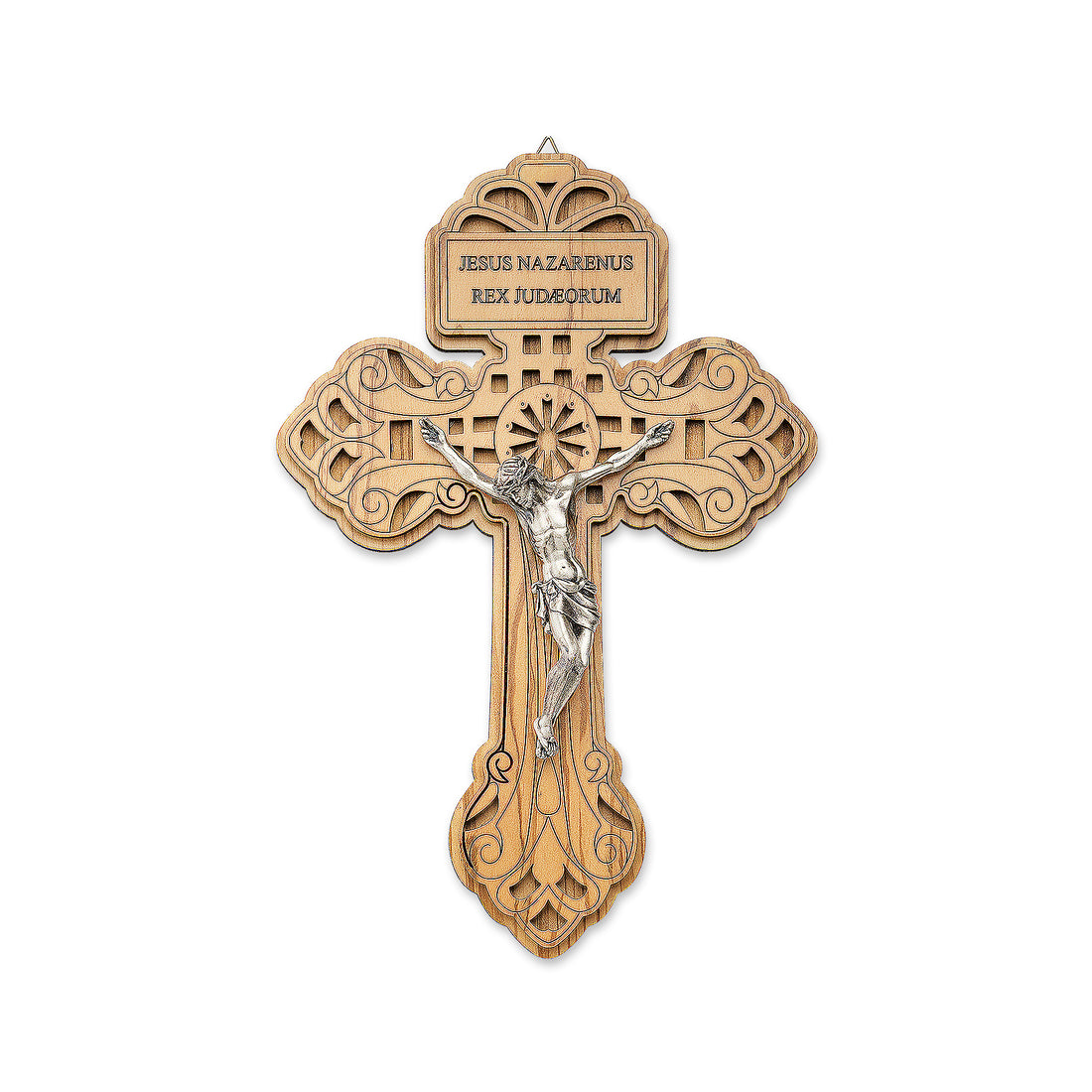
THE PARDON CRUCIFIX
CRUCIFIX OF FORGIVENESS
THE SACRAMENTALS
Holy Mother Church instituted sacramentals. These are sacred signs with which, imitating in some way the
sacraments, effects are expressed, especially spiritual, obtained through the intercession of the Church. Through them, men are prepared to receive the main effect of the sacraments and the various circumstances of life are sanctified. (CCC 1667)
Sacramentals do not confer the grace of the Holy Spirit in the manner of sacraments, but through the prayer of the Church they prepare to receive it and prepare to cooperate with it. (CCC 1670)
WHAT IS THE CRUCIFIX OF FORGIVENESS?
The Crucifix of Forgiveness is a powerful Catholic sacramental approved by Pope Saint Pius to the sufferings of Jesus and Mary is when we obtain the promised graces.
DESCRIPTION OF THE CRUCIFIX OF FORGIVENESS
On the front, just above Jesus' head, we find the testimony of his royalty, the so-called “Titulus Crucis”.
This inscription, “Iesus Nazarenus Rexiudæorum”, refers to the original that is preserved in the Basilica of the Holy Cross in Jerusalem in Rome, recovered according to the tradition of Saint Helen on Golgotha, it is intended to be a testimony of the kingship of Christ. In fact, although the Relic of the Holy Cross is not complete, two words continue to shine, respected even by the passage of time: “Nazarenus Rex”, “The Nazarene King”. A clear prophecy engraved on the wood to reiterate the fact that before the reign of Christ all others disappear.
On the back of the Cross in the middle of the 2 lateral arms, we find the image of a Sacred Heart and two inscriptions, the first in the horizontal portion, is the prayer for forgiveness that gives this Crucifix its name: “Father, forgive them.” (Lk 23,34). Below and at the foot of the Cross, also on the back, the anagram of Mary is found as a figure of Our Lady, occupying the feet of the Cross, which was the place that Mary occupied during the crucifixion of Jesus.
On the back of the Crucifix, in the center, we find a brilliant image of the Sacred Heart of Jesus, surrounded by two inscriptions that remember the infinite mercy of the Savior towards sinners. By pronouncing this phrase, Jesus asks the Father to forgive those who crucified him, which is why it is no coincidence that this Crucifix is called the “Crucifix of Forgiveness.”
The second inscription, on the other hand, is a prayer of love exclaimed by Jesus against the ingratitude of men, as demonstrated by the visions of Saint Margaret Mary of Alacoque, when, on June 15, 1675, while she was absorbed in prayer before the Blessed Sacrament, Jesus appeared to him, showing him his Heart and saying:
Here is this Heart that has loved men so much.
Continuing with the description of the Crucifix of Forgiveness, we see that on the back, but at the bottom at the foot of Jesus' feet, there is a letter “M” to which a letter “A” is superimposed, which corresponds to the most widespread and well-known Marian anagram in the field of sacred art, in fact, we often find it on the vestments of priests.
It has a double meaning: on the one hand, the two letters represent the Latin expression “Auspicio María”, which literally translated means “under the protection of Mary”, and on the other, they are an implicit reference to the greeting that the Archangel Saint Gabriel addressed to Our Lady when she announced that she would become the Mother of the Savior: “Hail Mary.”
Just above this anagram, we see that he is crowned by a star that represents “Mary Morning Star”, one of the attributes with which we turn to Our Lady in the context of the Lauretan litanies of the Holy Rosary.
There is a version of the Crucifix of Forgiveness from which the Miraculous Medal and the Medal of Saint Benedict hang on both sides, although the most common thing is to find the simplest version in which the medals are suppressed. For this reason, in the Combat Rosaries (used in the First and Second World Wars) there are separate medals that appear added separately to the Crucifix.
THE ORIGIN OF THE CROSS OF FORGIVENESS
This Crucifix of Forgiveness was introduced at the Marian Congress in Rome in 1904, with the help of Cardinal Coullié, Archbishop of Lyon, France, obtaining general approval. The project of unity around the Crucifix of Forgiveness was presented to his Holiness, Saint Pius X, who declared that whoever carries or kisses the Cross of Forgiveness receives an indulgence of forgiveness for himself and for the souls in Purgatory.
During the First World War, the North American Army distributed among its soldiers a multitude of Rosaries, known for that reason as “Combat Rosaries”, and which had been the

3 comments
I really loved this explanation. I already bought the crosses for my family. God bless you always.
Me gusto mucho la historia de la CRUZ DEL PERDON, GRACIAS.
Me gusto mucho la historia de la CRUZ DEL PERDON, GRACIAS.